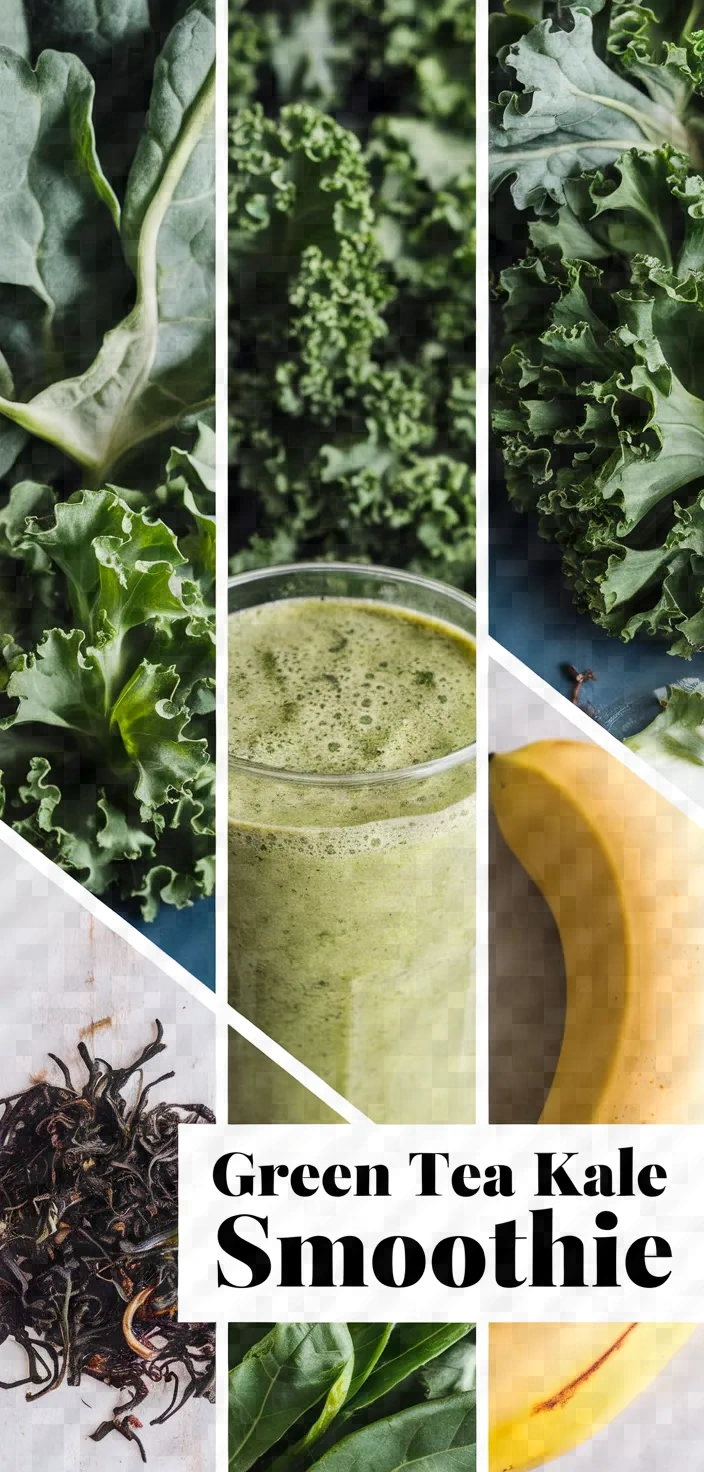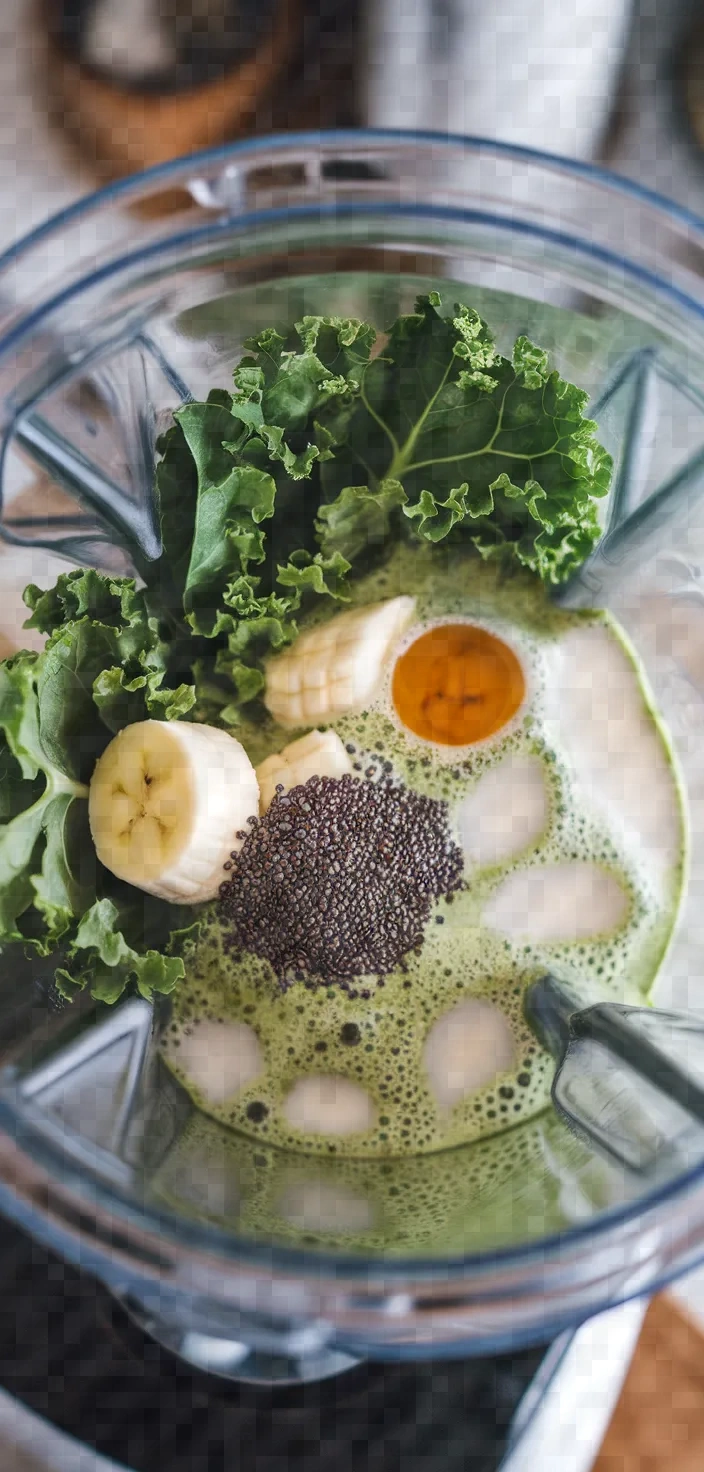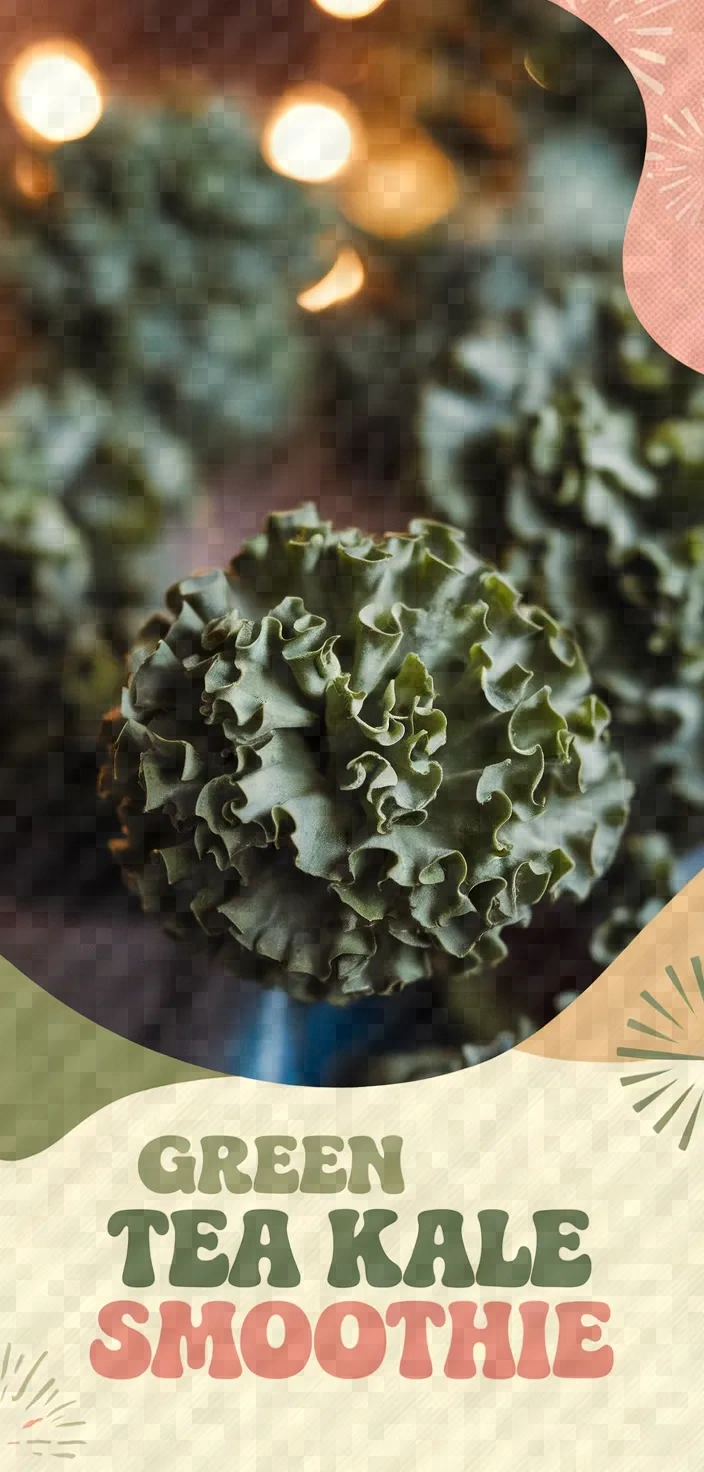Green Tea Kale Smoothie Recipe
Whipping up this kale and banana smoothie feels like treating myself to a nourishing green potion that kick-starts my day with a vibrant boost. The blend of kale, banana, and chia seeds, complemented by the subtle notes of green tea and almond milk, creates a refreshing and creamy drink that’s both energizing and deliciously satisfying.

I love jumpstarting my morning with a revitalizing Green Tea Kale Smoothie. This blend of kale and banana is boosted with brightness by the green tea, which is just a touch bitter.
The smoothie is so full of good-for-you stuff, from the antioxidants and vitamins in its main ingredients to the honey that sweetens it just right and the chia seeds that give it an omega-3 boost.
Green Tea Kale Smoothie Recipe Ingredients

- Kale: Packed with vitamins A, C, and K; high in fiber.
- Banana: Natural sweetness; rich in potassium and carbohydrates.
- Green Tea: Antioxidant-rich; provides gentle caffeine boost.
- Almond Milk: Low-calorie; a source of vitamin E and healthy fats.
- Honey: Natural sweetener; contains antioxidants.
- Chia Seeds: High in omega-3 and fiber; adds thickness.
Green Tea Kale Smoothie Recipe Ingredient Quantities
- 1 cup kale, tightly packed
- 1 small banana
- 1/2 cup green tea, brewed and cooled
- 1/2 cup almond milk or other plant-based milk
- 1 tablespoon honey or agave syrup
- 1 tablespoon chia seeds
- 1/2 cup ice
How to Make this Green Tea Kale Smoothie Recipe
1. Collect all components and make certain that the green tea has been prepared and has cooled to ambient room temperature.
2. Rinse the kale very well in cold water to remove any dirt or impurities.
1. Strip the leaves from the kale stems.
2. Slice the leaves into 1/2-inch (12-mm) ribbons.
3. Break the banana into chunks after peeling it to blend more easily.
4. Put the kale in the blender, tightly packing it into the cup.
5. Add the
1/2 cup
of
cool
green tea.
6. Combine the following ingredients.
Add the 1/2 cup of almond milk, or your preferred plant-based milk.
7. Add the tablespoon of honey or agave syrup to sweeten.
8. Add the tablespoon of chia seeds to the blender with the other ingredients. They should be sprinkled in and not dumped in.
9. Place 1/2 cup of ice in your blender for a truly refreshing smoothie.
10. Mix at high velocity until you achieve a smooth and creamy texture. Transfer to a drinking vessel and savor without delay.
Green Tea Kale Smoothie Recipe Equipment Needed
1. Blender
2. Knife
3. Cutting board
4. Measuring cups
5. Measuring spoons
6. Mixing spoon
7. Drinking glass or cup
FAQ
- Q: Can I use a different leafy green instead of kale?Kale can be swapped out for spinach or Swiss chard in a recipe. These leafy greens have a more delicate flavor than kale, making them suitable substitutes in any dish calling for the sturdier green.
- Q: How can I make the smoothie sweeter?Increase sweetness by adding more honey or agave syrup, or use a ripe banana.
- Q: Can I use dairy milk instead of almond milk?A: Absolutely, you can use regular milk or any other milk substitute according to your preference.
- Q: How far in advance can I prepare this smoothie?A: You can prepare it a few hours in advance and store it in the fridge, but it’s best enjoyed fresh.
- Q: What can I substitute for chia seeds?Flaxseeds, hemp seeds, or none at all if you prefer. You can use them.
- Q: Is there a caffeine-free alternative for green tea?You can use herbal tea instead of green tea for a version that is free of caffeine, and you can also leave out the green tea entirely.
- Q: How can I boost the protein content of this smoothie?A: Increase the amount of protein you take in by adding a scoop of protein powder or a spoonful of nut butter.
Green Tea Kale Smoothie Recipe Substitutions and Variations
Kale, one of the most wholesome and nutrient-dense leafy vegetables, is a cousin to cabbage, broccoli, and Brussels sprouts. Kale is an excellent source of several vitamins and minerals, including:
– Vitamin K
– Vitamin A
– Vitamin C
– Folate
– Calcium
– Potassium
Unlike many other green leafy vegetables, kale can survive winter temperatures as low as 20 degrees Fahrenheit. After a frost, the leaves are even sweeter, having stored more sugar while the temperatures were low.
Spinach
Per cup: 7 calories 1 g. 1.01 mg. 6.7 mg. 210 mg. 7430 IU. 0.39 mg. 20.4 mg. 0.1 g. 0.5 g.
Nutritional analysis
Percentage of Daily Values per serving (based on a 2,000-calorie diet):
Calories: 0.4% Protein: 2.4% Carbohydrates: 0.5% Total Fat: 0%
Saturated Fat: 0% Cholesterol: 0%
Vitamins
Vitamin A: 280% Vitamin C: 40% Vitamin D: 0% Vitamin E: 80% Vitamin K: 100%
Vitamin B1 (Thiamine): 60% Vitamin B2 (Riboflavin): 61% Vitamin B3 (Niacin): 25% Vitamin B5 (Pantothenic acid): 20% Vitamin B6: 15%
Vitamin B7 (Biotin): Not Available Vitamin B9 (Folate): 58% Vitamin B12: Not Available
Calcium: 10% Iron: 15% Potassium: 11% Magnesium: 30%
Zinc: 15%
Other Nutrients:
Purines: Not Available Amino Acids (mg): 55 mg. Cysteine: 20 60 mg. Aspartic acid: 6400 60 mg. Glutamic acid: 6000 60 mg. Glycine: 160 mg. Proline: 150 mg. Serine: 560 mg. Tyrosine: 80 mg. Some other amino acids are also present in spinach but they are not listed here.
— Also called silverbeet and perpetua beet.
— A leafy vegetable with thick, often colored ribs.
— A biennial that usually grows as an annual.
— Related to beets and spinach, and a member of the family Chenopodiaceae (goosefoot family).
— Grows best in cool weather and needs fertile soil.
A banana is an elongated, edible fruit produced by several kinds of large herbaceous flowering plants in the genus Musa. In some countries, the term “banana” is reserved for the dessert variety, while the term “plantain” is used for the cooking variety.
Excluding the peel, a typical banana is about 75% water and 25% solid matter. The solid matter is composed primarily of carbohydrates (about 23% of the total weight of the banana); weight for weight, bananas contain about the same amount of carbohydrate as cooked rice or pasta. Of the carbohydrates in a banana, about 50% are fructose and 25% glucose; only about 5% are starch (and even less of it is in the form of resistant starch, which is found in unripe bananas). Of the weight of the solid matter, only about 4% is protein (and of that, none of the amino acids are found in sufficient quantities to meet the definition of a complete protein). By weight, the only nutrients that come close to the daily value for most people are vitamin C and vitamin B6. Both of those vitamins are found primarily in the regions just beneath the peel, which is why a peeled banana looks mostly white, with some pale yellow areas.
Bananas are unusual in several important respects. They are the only common fruit that is radioactive. They are also the only common fruit that is a staple food for entire populations. Inasmuch as half a banana provides about 70% of the daily value for vitamin B6, and is made up of about 4% protein, most people, if they ate nothing prior to the time the banana segment was consumed, would probably be better off health-wise eating half a banana than half a hot dog.
The avocado is a large berry that has a high-fat content. Avocados are rich in
nutrients and healthy fats. They are an excellent source of monounsaturated fat
and vitamin E, a fat-soluble vitamin that often goes short in the average diet.
They are also a very good source of folate, a water-soluble B vitamin that acts in
ways closely analogous to vitamin E. Folate, like vitamin E, has health benefits that
are very important to both men and women. Monounsaturated fats and folate provide
the basis for avocado’s health benefits.
Mango
Matcha contains a higher concentration of nutrients than most forms of green tea. One unique aspect of matcha is the way the tea leaves are grown. For example:
– Unlike tea plants that are grown in full sun, the tea plants used to make matcha are grown in the shade. This increases the chlorophyll level in the leaves, which in turn makes matcha a much greener tea.
– When you make cup of matcha, you’re actually consuming the powdered tea leaf, which has more nutrients and antioxidant power than the brewed green tea you get with a tea bag. These are just a couple of reasons why matcha is considered to be a super-green tea.
Powdered matcha (1 teaspoon mixed with water)
White tea, when brewed and then cooled
Nondairy options abound, but almond milk is the most popular. Its charm lies in its nutty flavor and slightly creamy consistency that most closely resembles cow’s milk. Nutritionally speaking, it’s a mixed bag. Unsweetened almond milk is low in calories and might be a good fit for those keeping an eye on their waistline; it has only about 30 calories per cup, compared to approximately 90 calories per cup for skim milk and around 150 for whole milk. Almond milk is also low in protein. Most plant milks are. Soy milk is the protein king of the nondairy world—its protein content is comparable to that of cow’s milk. Nut milks, including almond, come in quite a bit lower. Almond milk has roughly 1 gram of protein per cup. Its base of water and ground nuts means that it’s not a significant source of any nutrient, really. If you’re going to drink almond milk, or any of these new plant milks, consider it a vehicle for whatever else you put in your glass. If you do opt for it, choose the unsweetened variety.
Milk made from oats
Also known as:
Oat beverage, oat drink, oat milk (though this term is somewhat controversial; see “Oat milk vs. oat drink;
Nutrition and impact on health:
17
Soy milk
Sweet honey is a familiar presence in many households, appearing regularly in recipes and serving as the base for a number of beverages. Largely thanks to these and other everyday associations, honey’s taste and texture are perhaps more appreciated than its remarkable nature as a natural food and health product. Even so, increasing numbers of Americans appear to be catching on, given a recent uptick in the diversifying use of honey across the spectrum of food and drink as well as in herbal medicine and natural body care.
Maple syrup in its purest form—just as Mother Nature intended—begins as a sweet sap derivation from sugar maple trees, or sometimes other maple species. Ideal conditions for sap flow occur when late-winter cold nights (below -5°C/23°F) are followed by warm, sunny days (above 0°C/32°F). Under these temperature conditions, pressure from tree roots forces sap upward from the ground and into the tree. As sap rises, it also fills the tree’s vascular system with sweet sap destined to feed this springtime growth. In a healthy sugar maple, for instance, up to 40 liters of sap can be collected over a single sugaring season (February to April), which is not much sap when you consider that it takes 40 to 80 times more sap to make just one liter of syrup. Right after gathering sap, the next step is to boil it down to syrup.
Syrup made from dates.
Pro Tips
1. Freeze the Banana: For an extra creamy and cold smoothie, use a frozen banana instead of a fresh one. This will also give your smoothie a thicker texture without needing to add more ice.
2. Pre-soak Chia Seeds: If you have time, soak the chia seeds in a small amount of water or almond milk for about 10 minutes before adding them to the blender. This will help them blend more smoothly and release their nutrients more effectively.
3. Add a Squeeze of Lemon: A small squeeze of fresh lemon juice can enhance the flavors and add a refreshing zing to your smoothie.
4. Blend in Stages: Begin by blending the kale with the liquid ingredients (green tea and almond milk) first to ensure it breaks down completely before adding the other ingredients. This step can help achieve a smoother consistency.
5. Customize Sweetness: Taste the smoothie before pouring and adjust the sweetness as needed. You may find that the natural sweetness of the banana is sufficient, allowing you to reduce or omit the honey or agave syrup.

Green Tea Kale Smoothie Recipe
My favorite Green Tea Kale Smoothie Recipe
Equipment Needed:
1. Blender
2. Knife
3. Cutting board
4. Measuring cups
5. Measuring spoons
6. Mixing spoon
7. Drinking glass or cup
Ingredients:
- 1 cup kale, tightly packed
- 1 small banana
- 1/2 cup green tea, brewed and cooled
- 1/2 cup almond milk or other plant-based milk
- 1 tablespoon honey or agave syrup
- 1 tablespoon chia seeds
- 1/2 cup ice
Instructions:
1. Collect all components and make certain that the green tea has been prepared and has cooled to ambient room temperature.
2. Rinse the kale very well in cold water to remove any dirt or impurities.
1. Strip the leaves from the kale stems.
2. Slice the leaves into 1/2-inch (12-mm) ribbons.
3. Break the banana into chunks after peeling it to blend more easily.
4. Put the kale in the blender, tightly packing it into the cup.
5. Add the
1/2 cup
of
cool
green tea.
6. Combine the following ingredients.
Add the 1/2 cup of almond milk, or your preferred plant-based milk.
7. Add the tablespoon of honey or agave syrup to sweeten.
8. Add the tablespoon of chia seeds to the blender with the other ingredients. They should be sprinkled in and not dumped in.
9. Place 1/2 cup of ice in your blender for a truly refreshing smoothie.
10. Mix at high velocity until you achieve a smooth and creamy texture. Transfer to a drinking vessel and savor without delay.
